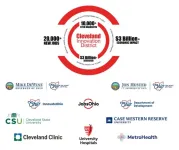(Press-News.org) CLEVELAND – Since the Cleveland Innovation District launched in 2021, the founding institutions have made significant progress, including exceeding many of the targets set by the Ohio Department of Development and JobsOhio. Collectively, the institutions participating in this $500 million public-private initiative have created more than 2,600 jobs, spent nearly $1.2 billion on research and innovation, commenced construction of two new research facilities, created dedicated research space comprising more than 550,000 square feet, and awarded more than 7,300 degrees and certificates to support workforce development.
“The Cleveland Innovation District’s progress over the last three years has been remarkable," said Governor Mike DeWine. "Ohio is a world leader in innovative healthcare and research, and I’m confident we’ll continue to see life-changing medical advancements from the talented teams that are part of the Cleveland Innovation District.”
Through the Cleveland Innovation District (CID), the partners -- Case Western Reserve University, Cleveland Clinic, Cleveland State University, The MetroHealth System and University Hospitals -- in collaboration with the Ohio Department of Development and JobsOhio aim to contribute $3 billion to the regional economy by 2030. They plan to achieve this by generating 20,000 direct and indirect jobs that will result from increased investment in research and product innovation, construction spending and furthering the educational profile of our Northeast Ohio community.
“When we launched the Innovation District, it was our aspiration that it would generate more jobs, more STEM talent and more research and investment funding to solidify Cleveland as an international health research center of excellence, and it is encouraging to see that we are making progress toward those goals,” said Lt. Governor Jon Husted, director of InnovateOhio. “These interim reports provide an opportunity to celebrate milestones, while holding all of the partners accountable for delivering on what was promised.”
“The Cleveland Innovation District is poised to be a center of excellence that acts as a catalyst for ongoing investment in Northeast Ohio,” said JobsOhio President and CEO J.P. Nauseef. “This extraordinary collaboration showcases the region’s world-class research and learning institutions as the Cleveland Innovation District attracts and creates new businesses and talent needed to ensure the state is a global leader in the healthcare and IT sectors.”
“The Cleveland Innovation District is a great example of how a community can come together to advance technology and innovation and drive economic growth and transformation throughout Ohio,” said Lydia Mihalik, director of the Department of Development. “The progress they’ve made so far is a testament to what’s possible when great minds converge with a shared vision for progress. Their accomplishments are actively shaping the future workforce and empowering individuals with the skills needs to thrive in the heart of innovation.”
"It has been an immense privilege to witness the remarkable synergy among our anchor partners,” said Cliff A. Megerian, MD, FACS, Current Chair of the Cleveland Innovation District and CEO of University Hospitals. “Together, we have coalesced into a dynamic force, achieving significant milestones since the launch in 2021. The progress we've made underscores our collective commitment to elevating the region. I look forward to continuing this extraordinary journey, working hand-in-hand with our partners and the entire community, as we propel the Cleveland Innovation District to even greater heights.”
Milestones achieved by the five institutions since their last update in 2021 include:
Case Western Reserve University:
With a priority to grow its research portfolio to $600 million as soon as possible, Case Western Reserve University is moving quickly toward that goal, reporting to the federal government FY23 research expenditures of $554 million.
To support researchers and their expanded research portfolios, Case Western Reserve is also investing in infrastructure. The university is about to break ground on its state-of-the-art $300 million, 200,000-square-foot Interdisciplinary Science and Engineering Building (ISEB), scheduled to open in fall 2026.
CWRU is elevating technology translation and catalyzing the innovation ecosystem with the development of a new start-up incubator designed for 40 early-stage businesses in the biotech, health tech, and engineering fields.
CWRU has embarked on a major strategic initiative to add 100 net new tenured and tenure-track faculty positions — an integrated effort across the university and across a variety of resource pools to enhance the impact of university activity.
Cleveland Clinic:
Began construction of two new research buildings, totaling approximately 300,000 square feet, on Cedar Avenue in CID. The state-of-the-art facilities, which will be home to the Sheikha Fatima bint Mubarak Global Center for Pathogen & Human Health Research, will significantly increase laboratory research space on Cleveland Clinic’s main campus.
Opened the first research facilities on main campus dedicated to the Cleveland Innovation District. Several of Cleveland Clinic’s fastest-growing research programs moved into the 45,000 square feet of modern laboratory and computational space, including the Center for Computational Life Sciences, Center for Immunotherapy and Precision Immuno-oncology and Center for Therapeutics Discovery.
Commissioned a new biosafety level 3 laboratory for sophisticated pathogen research, operating under stringent biosafety protocols set by the Centers for Disease Control. The lab provides an important resource for scientists to safely develop diagnostics, treatments and vaccines to prevent and treat current and future infectious diseases.
Created nearly 2,000 new jobs since 2021 related to the CID, exceeding the goal of 1,000 new full-time equivalency employees. In collaboration with Cleveland State University, Cleveland Clinic has created courses and degrees for new workforce demands. Since 2021, there have been more than 2,000 degrees supported and certificates that were awarded in programs such as phlebotomy, cardiac ultrasound and diagnostic medical sonography.
Cleveland Clinic formed research partnerships with IBM in addition to Canon. Together with IBM, Cleveland Clinic on its main campus opened the first quantum computer dedicated to healthcare. The research teams have launched more than 50 research projects leveraging advanced computing technologies and begun publishing results.
In 2023, Cleveland Clinic received $435 million in research funding, which supported more than 3,700 active research projects.
Cleveland State University:
Awarded a total of 2,031 degrees in STEM/CS programs in the first three years of the project; and 3,270 certificate programs in workforce development fields have been completed.
Saw a 27% increase in the number of students enrolled in the 16 degree programs targeted by JobsOhio over the 2019 academic year baseline. Year-over-year retention of first year undergraduate and master’s students has increased by eight points.
Two hundred organizations employed students in co-op/internships from JobsOhio-targeted programs for Year 2 (Su22/F22/Sp23), an increase of 115% from the previous year.
In May 2023, 457 students graduated from the JobsOhio-targeted STEM/CS programs at the bachelor’s, master’s and PhD levels. Of the 351 students who responded to our survey, 86% found professional employment related to their field of study, and 7% are pursuing additional education, indicating that the demand for graduates with these STEM/CS degrees remains high.
Hosted a total of 778 middle school and high school students in STEM-related summer camps in the previous two years.
The MetroHealth System:
Opened the region’s first Vector Production facility, improving access to critical care therapies.
Launched and funded Ovatient, a dedicated virtual care start-up.
Partnered with AT&T to address digital disparities and address social drivers of health.
Voted the most impactful innovation at the Center for Health Affairs for innovations in cellular immunotherapy manufacturing.
Collaborated with CWRU on AI research to improve health care access for minorities.
Established research and programming to build digital twin neighboorhoods – led by MetroHealth with Cleveland Clinic and CWRU.
University Hospitals:
Attained $197 million in annual research funding, eclipsing the JobsOhio milestone goal by 15% and last year’s actual by 11%.
Signed a 10-year agreement with Oxford University, launching the Oxford-Harrington Rare Disease Centre Therapeutics Accelerator to find cures for rare diseases.
Managed more than 3,400 active clinical trials and research studies with a 20% increase in patient enrollment year over year. For example, there is a multi-institutional effort that includes The MetroHealth System, Cleveland Clinic and University Hospitals to identify underserved populations within Northeast Ohio and leverage hypertension data to serve our surrounding communities with the right resources and preventative care.
The National Institutes of Health awarded Dr. Grace McComsey and Case Western Reserve University’s CTSC a seven-year, $56.3 million grant renewal in 2023 to advance initiatives that improve people’s health in Northern Ohio and beyond. The CTSC also added the University of Toledo and Northeast Ohio Medical University to its collaborative that included Cleveland Clinic, The MetroHealth System, University Hospitals and the VA Northeast Ohio Healthcare System.
Expanded the Wesley Center for Immunotherapy by more than 10,000 square feet, where in conjunction with UH Seidman Cancer Center, we have launched a clinical trial in which an “in-house” CAR T-cell therapy is manufactured within 24 to 48hrs and others are manufactured in 8 days, compared to an average of 12-30 days in commercially available CAR T-cell therapy trials. UH CAR T-cell therapy patients have an 80% overall response in complete and partial remission.
Exceeded 10 year job creation targets by 80%.
Established the UH Radiology A.I. & Diagnostic Innovation Collaborative (RadiCLE) -- an artificial intelligence hub that already paved the way for FDA-approval of fracture detection software by AZMed. END
Cleveland Innovation District partners exceeding many targets set by state and JobsOhio
25 examples of progress showcase the impact of successful collaboration
2024-04-12
ELSE PRESS RELEASES FROM THIS DATE:
A third of women experience migraines associated with menstruation, most commonly when premenopausal
2024-04-12
WASHINGTON (April 12, 2024) – A third of the nearly 20 million women who participated in a national health survey report migraines during menstruation, and of them, 11.8 million, or 52.5%, were premenopausal. The analysis was conducted by researchers at Georgetown University Medical Center and Pfizer, Inc., which makes a migraine medication.
Because of the underuse of medications to help treat or prevent menstrual migraines, investigators wanted to understand how common menstrual migraines were and which groups of women could most benefit from potential therapies. The study will be presented April 16, at the American Academy of Neurology ...
MD Anderson Research Highlights for April 12, 2024
2024-04-12
HOUSTON ― The University of Texas MD Anderson Cancer Center’s Research Highlights showcases the latest breakthroughs in cancer care, research and prevention. These advances are made possible through seamless collaboration between MD Anderson’s world-leading clinicians and scientists, bringing discoveries from the lab to the clinic and back.
Recent developments at MD Anderson offer insights into a combination strategy to improve immunotherapy responses, promising trial results for patients with tumors harboring BRAF mutations, a maintenance strategy for patients with acute myeloid leukemia following chemotherapy, a strategy ...
Soft Robotics appoints new Deputy Editor-in-Chief, Barbara Mazzolai, PhD
2024-04-12
Mary Ann Liebert, Inc., is pleased that Barbara Mazzolai, PhD, has been appointed the new Deputy Editor-in-Chief of the bimonthly journal Soft Robotics. Dr. Mazzolai joins Barry Trimmer, PhD, as part of the executive editorial team for the journal.
Soft Robotics is the leading robotics journal devoted to the emerging technologies and developments of soft and deformable robots. The journal’s coverage includes flexible electronics, materials science, computer science, and biomechanics. The journal breaks new ground as the first to answer the urgent need for research on robotic technology that can safely ...
Wiley releases Mass Spectra of Designer Drugs 2024 to accelerate forensics analysis of fentanyls, cannabinoids, and more
2024-04-12
Wiley, one of the world’s largest publishers and a global leader in research and learning, today announced the 2024 release of the Mass Spectra of Designer Drugs.
This indispensable spectral database serves as a cornerstone for forensic laboratories worldwide, enabling swift identification of illicit substances. Sourced from both legal and underground literature, it provides access to the latest novel psychoactive substances (NPS) like variants of fentanyl, xylazine, various opioids, synthetic cannabinoids, and more.
This annually refreshed database provides access to 35,094 mass spectra representing 26,712 unique ...
Freestanding emergency departments are popular, but do they function as intended?
2024-04-12
By Ann Kellett, Texas A&M University School of Public Health
Freestanding emergency departments (EDs) — either satellite branches of hospitals or independently operated facilities — have popped up across the country. Texas has the most, with 338 freestanding EDs as of May 2023, and these facilities handle nearly one quarter of all emergency department visits in the state.
Now, a new study from the Texas A&M University School of Public Health is the first to compare the characteristics of visits to freestanding EDs with visits to traditional hospital-based ...
University of Cincinnati experts present at national neurology conference
2024-04-12
University of Cincinnati researchers will present abstracts at the American Academy of Neurology annual meeting 2024, April 13-18 in Denver, Colorado.
Two-component treatment leads to improvement for patients
Late-onset Pompe disease (LOPD) is a rare, inherited genetic disease caused by the accumulation of glycogen, the body’s stored form of glucose, in muscles and other organs. Left untreated, the muscle weakness it causes can lead to the loss of the ability to walk and breathing impairment.
A research team led by UC’s ...
Bonobos are more aggressive than previously thought
2024-04-12
Chimpanzees and bonobos are often thought to reflect two different sides of human nature—the conflict-ready chimpanzee versus the peaceful bonobo—but a new study publishing April 12 in the journal Current Biology shows that, within their own communities, male bonobos are more frequently aggressive than male chimpanzees. For both species, more aggressive males had more mating opportunities.
“Chimpanzees and bonobos use aggression in different ways for specific reasons,” says anthropologist and lead author Maud Mouginot of Boston University. “The idea is not to invalidate the ...
How seaweed became multicellular
2024-04-12
A deep dive into macroalgae genetics has uncovered the genetic underpinnings that enabled macroalgae, or “seaweed,” to evolve multicellularity. Three lineages of macroalgae developed multicellularity independently and during very different time periods by acquiring genes that enable cell adhesion, extracellular matrix formation, and cell differentiation, researchers report April 12 in the journal Molecular Plant. Surprisingly, many of these multicellular-enabling genes had viral origins. The study, which increased the total number of sequenced macroalgal genomes from 14 to 124, is the first to investigate ...
Melanomas resist drugs by ‘breaking’ genes
2024-04-12
Melanoma is the deadliest form of skin cancer. With global incidence rates rising, new, more effective treatments are necessary to alleviate the health burden of the disease. Important advances in recent years include doctors using genetic tests to look for specific mutations they can target for more personalised, effective treatment.
Around 1 in 2 melanoma patients will have mutations in the BRAF gene. This gene normally makes a protein which helps control cell growth, but mutations can cause the cells to grow and divide uncontrollably instead, happening in many different types of cancer including ...
Africa’s iconic flamingos threatened by rising lake levels, study shows
2024-04-12
It is one of the world’s most spectacular sights – huge flocks or “flamboyances” of flamingos around East Africa’s lakes – as seen in the film Out of Africa or David Attenborough’s A Perfect Planet.
But new research led by King’s College London has revealed how the lesser flamingo is at danger of being flushed out of its historic feeding grounds, with serious consequences for the future of the species.
For the first time satellite earth observation data has been used to study all the key flamingo feeding lakes in Ethiopia, Kenya and Tanzania over two decades and it identified how rising ...
LAST 30 PRESS RELEASES:
House sparrows in northern Norway can help us save other endangered animals
Crohn's & Colitis Foundation survey reveals more than 1/3 of young adults with IBD face step therapy insurance barriers
Tethered UAV autonomous knotting on environmental structures for transport
Decentralized social media platforms unlock authentic consumer feedback
American Pediatric Society announces Vanderbilt University School of Medicine as host institution for APS Howland Visiting Professor Program
Scientists discover first method to safely back up quantum information
A role for orange pigments in birds and human redheads
Pathways to net-zero greenhouse gas emissions for Southeast Asia
A JBNU–KIMS collaborative study on a cost-effective alloy matches superalloys for power plants and energy infrastructure
New study overturns long-held model of how plants coordinate immune responses.
New AI model predicts disease risk while you sleep
Scientists discover molecular ‘reshuffle’ and crack an 80-year-old conundrum
How stressors during pregnancy impact the developing fetal brain
Electrons lag behind the nucleus
From fungi to brain cells: one scientist's winding path reveals how epigenomics shapes neural destiny
Schizophrenia and osteoporosis share 195 genetic loci, highlighting unexpected biological bridges between brain and bone
Schizophrenia-linked genetic variant renders key brain receptor completely unresponsive to both natural and therapeutic compounds
Innovative review reveals overlooked complexity in cellular energy sensor's dual roles in Alzheimer's disease
Autism research reframed: Why heterogeneity is the data, not the noise
Brazil's genetic treasure trove: supercentenarians reveal secrets of extreme human longevity
The (metabolic) cost of life
CFRI special issue call for papers: New Frontiers in Sustainable Finance
HKU Engineering scholar demonstrates the smallest all-printed infrared photodetectors to date
Precision empowerment for brain "eavesdropping": CAS team develops triple-electrode integrated functional electrode for simultaneous monitoring of neural signals and chemical transmitters during sleep
Single-capillary endothelial dysfunction resolved by optoacoustic mesoscopy
HKU three research projects named among ‘Top 10 Innovation & Technology News in Hong Kong 2025’ showcasing excellence in research and technology transfer
NLRSeek: A reannotation-based pipeline for mining missing NLR genes in sequenced genomes
A strand and whole genome duplication–aware collinear gene identification tool
Light storage in light cages: A revolutionary approach to on-chip quantum memories
Point spread function decoupling in computational fluorescence microscopy
[Press-News.org] Cleveland Innovation District partners exceeding many targets set by state and JobsOhio25 examples of progress showcase the impact of successful collaboration




